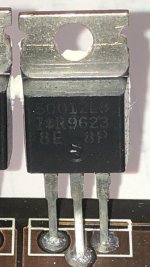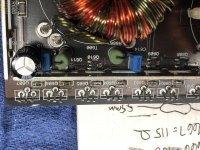The original outputs (at least what is on the board now) are 50012L8s.
Thanks, Perry - I was having a hard time making sense of the series breakdown in the tutorial but this helps seeing it in use. I suppose that second band could have been violet at one point. Is it possible that last band just means its
fusible? I tried lightly buffing the surface without luck, the color comes off with very little pressure, these resistors are heavily aged and the leads are discolored; I'm guessing they have seen a lot of heat throughout their life.
I'll order some 2W 4.7s (1% to be safe).
Thanks, Perry - I was having a hard time making sense of the series breakdown in the tutorial but this helps seeing it in use. I suppose that second band could have been violet at one point. Is it possible that last band just means its
fusible? I tried lightly buffing the surface without luck, the color comes off with very little pressure, these resistors are heavily aged and the leads are discolored; I'm guessing they have seen a lot of heat throughout their life.
I'll order some 2W 4.7s (1% to be safe).
50012L8 isn't a part number. Post a photo of the face of the transistor.
You can order 1% but it's not necessary (there will be no benefit). These are not critical.
Confirm that the series-connected capacitors are not shorted.
You can order 1% but it's not necessary (there will be no benefit). These are not critical.
Confirm that the series-connected capacitors are not shorted.
Attached is the best photo I could get, the faces are a bit worn.
Ok I’ll save the money on 1% resistors and stick with the 5%.
Also, I verified that neither of the capacitors are shorted (I assume you were referring to the small blue C614 and C615?).
Ok I’ll save the money on 1% resistors and stick with the 5%.
Also, I verified that neither of the capacitors are shorted (I assume you were referring to the small blue C614 and C615?).
Attachments
I don't have photos showing the circuit board designation of the capacitors.
You're right about the part number. It may be an internal number.
For laser etched markings, if you wipe heatsink compound onto the face then wipe as much off as possible with a dry cloth, it can make the markings easier to read.
Are all 4 of the outputs the same?
You're right about the part number. It may be an internal number.
For laser etched markings, if you wipe heatsink compound onto the face then wipe as much off as possible with a dry cloth, it can make the markings easier to read.
Are all 4 of the outputs the same?
TT3, item #4.
If the outputs are not shorted, I'd leave them.
AFTER the amp is working perfectly and has worked for a while, then you could try several other options. I've had mixed results with the few times I used the 3710Z. The 540s have proved to be reliable.
If the outputs are not shorted, I'd leave them.
AFTER the amp is working perfectly and has worked for a while, then you could try several other options. I've had mixed results with the few times I used the 3710Z. The 540s have proved to be reliable.
Thanks, Perry. I’ll keep the outputs for now.
I’ll report back when all of my parts come in and when I get the PS squared away.
I’ll report back when all of my parts come in and when I get the PS squared away.
- Home
- General Interest
- Car Audio
- JL 500/1 Rev 2 No Output, worth repair?


